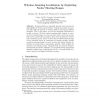Free Online Productivity Tools
i2Speak
i2Symbol
i2OCR
iTex2Img
iWeb2Print
iWeb2Shot
i2Type
iPdf2Split
iPdf2Merge
i2Bopomofo
i2Arabic
i2Style
i2Image
i2PDF
iLatex2Rtf
Sci2ools
DCOSS
2010
Springer
2010
Springer
Wireless Jamming Localization by Exploiting Nodes' Hearing Ranges
Jamming attacks are especially harmful when ensuring the dependability of wireless communication. Finding the position of a jammer will enable the network to actively exploit a wide range of defense strategies. Thus, in this paper, we focus on developing mechanisms to localize a jammer. We first conduct jamming effect analysis to examine how a hearing range, e.g., the area from which a node can successfully receive and decode the packet, alters with the jammer's location and transmission power. Then, we show that the affected hearing range can be estimated purely by examining the network topology changes caused by jamming attacks. As such, we solve the jammer location estimation by constructing a least-squares problem, which exploits the changes of the hearing ranges. Compared with our previous iterativesearch-based virtual force algorithm, our proposed hearing-range-based algorithm exhibits lower computational cost (i.e., one-step instead of iterative searches) and higher localiz...
DCOSS 2010 | Distributed And Parallel Computing | Hearing Ranges | Jammer Location Estimation | Jammer's Location |
| Added | 13 Oct 2010 |
| Updated | 13 Oct 2010 |
| Type | Conference |
| Year | 2010 |
| Where | DCOSS |
| Authors | Zhenhua Liu, Hongbo Liu, Wenyuan Xu, Yingying Chen |
Comments (0)

